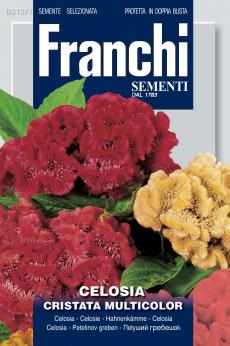
Celosia Cristata Multicolor
Celosia Cristata Multicolor Annual, rustic, ornamental plant about 20" tall with a cocks crest shaped flower in mixed vivid colours. Ideal for borders and flower beds but also good for cutting. This variety is perfect for borders and cutting. Celosia Cristata is allso known as cockscomb or crested celosia. It loves hot weather and will send up new stems all summer if you keep cutting it. It's great for a fresh cut flower, or you can hang the flowers upside down to dry them. They retain colors well and can be used for holiday decorations in fall and winter. Ideal for borders and flowerbeds also. A mix of red, pink, yellow, orange and some bicolors.
Celosias are a genus of flowering plants in the plant family Amaranthaceae which have furry looking flowers. The familial name Amaranthaceae comes from the Greek ἀμάραντος (amarantos), which means "unfading." Binomial Name: Celosia cristata; Common names: Celosia, Woolflower, Cockscomb, Crested cock’s comb
Belonging to the Amaranth family, this is Celosia argentea of the Cristata Group). Celosia get its name from the Greek word 'keleos' which means 'burning', a reference to the flame-like shape of the flower heads of some of the varieties. It is native to tropical and sub-tropical America, Africa and Asia.
Celosia argentea (Cristata Group) Coral-like is how Celosia argentea var. Cristata is often described, due to the shape of its flowers. And it will come as no surprise to you to discover that Cristata means 'crinkled', as this also aptly describes the shape of the flower heads. This group is sometimes referred to as the crest type of celosia. There are two distinctive kinds of Cristata. There is the narrow flat form, with wavy fan-like flowers, reminiscent of a cock's comb. Hence, its common name of 'cockscomb'. And there's also the larger, wider global form which is generally called 'brains', due to the structure of the flower head resembling the folds of the brain. Celosia argentea var. Cristata is available in rich jewel colours such as cerise pink, burgundy, orange, yellow, red and green.
Approx. 1,400 seeds per gram.
